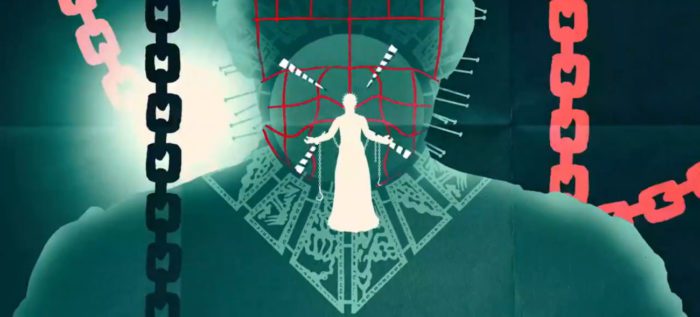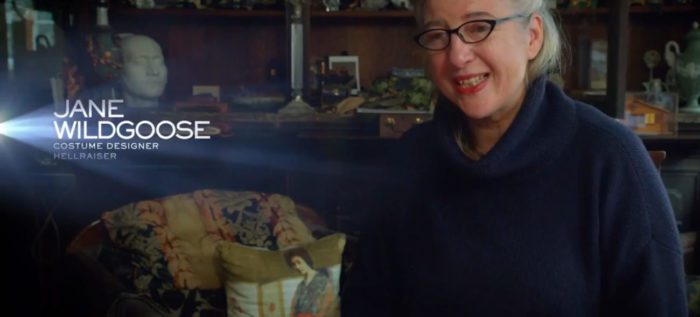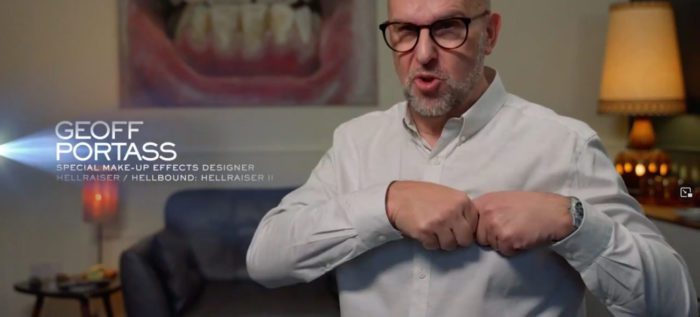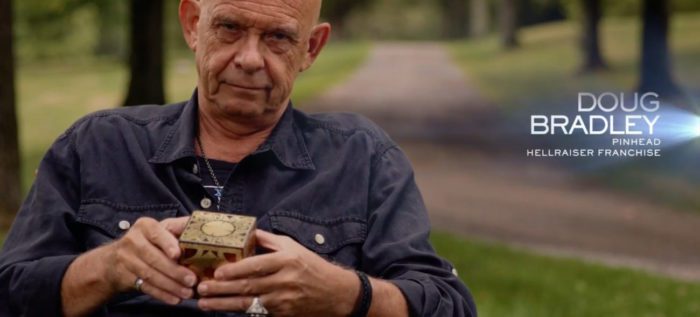Some monsters enjoy their work. For some monsters, their work is for a cause (and they may also enjoy it). For some monsters, their work is just something they do, whether there’s a cause or not (and whether or not there’s a cause can vary depending on the film or the individual kill). And for some monsters, their work is just that: work. A job. Maybe they enjoy it, and maybe you “deserve it,” maybe you don’t, but either way, it’s something that must be done, and, as the “employee,” they’re the one that’s going to do it. Punching in (perhaps literally) for this shift is Pinhead from the Hellraiser franchise.

After the intro, this episode of Behind the Monsters begins where these episodes always begin and, so far, have thrived: Pinhead’s origins.
Doug Bradley, who’s played Pinhead in eight of the ten Hellraiser films so far, has a unique connection with Clive Barker, Hellraiser creator, director, and writer of the first Hellraiser (1987). Bradley and Barker have known each other since they were children; this gave Bradley a unique experience in witnessing the character’s initial development.

We get an in-depth look at how Pinhead’s look was developed, as well as sprinkles of how his iconic status was accidental. In Hellraiser’s credits, Doug Bradley isn’t credited as “Pinhead,” but as “Lead Cenobite.” In the story the film is based on, not only is the head cenobite female, but the focus of the story is on the human family’s dynamics, drama, and story.
For Pinhead’s look, we hear from costume designer Jane Wildgoose, special make-up effects designer Geoff Portass, and Bradley. While it’s relatively common knowledge that Pinhead and the Cenobites’ looks were inspired by BDSM, self-mutilation, etc., Wildgoose gives specifics about where Pinhead’s specific look came from. Barker told her he was looking for “repulsive glamor,” and she looked at Piercing Fans International Quarterly (PFIQ) magazines for inspiration, eventually even going to a fishing shop to ask to see their “most brutal hooks.”

Portass reveals that the costumes and make-up of the Cenobites are “intrinsically linked.” He gives a detailed tale of how he created Pinhead’s make-up to follow Barker’s instructions not to lose Bradley’s face. This allowed Bradley the unique opportunity of being able to act as Pinhead without being behind a mask blocking his face or heavy effects makeup restricting him. Hearing about the many adjustments Portass made not only to allow Bradley to act without restriction but to also ensure that the “pins” actually showed up on the screen.
This is when Bradley gives us a more in-depth look at his performance. He recalls that the entire first day of filming, Barker gave him one note repeatedly: “Do less.” Bradley eventually realized that he could dial back his performance to a huge degree, as any small movement and any expression would be magnified and made dark and menacing by the make-up.
This leads into fans’ reflections on what makes Pinhead different from other monsters of the era. Rebekah McKendry, co-director and co-writer of All the Creatures Were Stirring, emphasizes just how much Pinhead’s character relied on an actor’s performance, portraying a very specific character. This gave Pinhead a different feel than a massive, masked monster with a weapon—he’s smart. His strength doesn’t come from his size or build but from his supernatural powers. His relationship to killing is more about the rules he must follow than taking gleeful joy in killing everyone in sight with a specific weapon. Dave Schilling, writer and co-host of Galaxy Brains, remarks that Pinhead is less of a traditional slasher and more of a psychological monster, getting at your specific fears as well as your specific desires.
Ryan Turek, Blumhouse producer, makes note of a very distinct difference between Pinhead’s personality and those of his contemporaries, including the ones who spoke: “Pinhead can be bargained with…He’s someone that loves a good conversation.” Barker elaborates, “You feel he’s a man of the world. He’s seen it all, and he’s bored with it all.” If something’s new or interesting or will restore order within the rules he follows for his job, he’ll pay attention. Having a monster be a character that the protagonists can interact with besides just being killed and can even influence is quite unique.

The flow of this Behind the Monsters episode is different from previous episodes covered here so far: while the preceding episodes go over each entry in varying levels of detail, including sequels, reboots, remakes, and the franchise’s future, and would cover subjects outside the films, such as fan films, appearances in other media, merchandising and costumes, and more. This 47-minute episode is very much focused on the first four films. This does make some sense: the first four Hellraiser films were the ones that received theatrical releases (the rest of the sequels so far have been straight-to-home-media), the ones that had Hellraiser creator Clive Barker involved, and the ones for which Hellraiser fans feel the most positivity.
However, those first four films are focused on so strongly that the sequels only get a few passing references. If you’re not familiar with the Hellraiser franchise, at the end of this episode, you’ll have a hard time even remembering the sequels’ plots, much less the titles (most of which are never mentioned). While in previous episodes, each entry in the featured franchise gets some form of appreciation, whether from fans, those involved in the making of the entry, or both, the only “praise” given to the Hellraiser sequels after Hellraiser: Bloodline (1996) is that they were a series of interesting ideas and the attempts to make each one different stylistically were sometimes interesting. The 2022 reboot film gets a few vague references accompanied by screenshots of articles. Of course, the lack of information given about the reboot could be because that, at the time of filming, perhaps there simply wasn’t much information available.
Perhaps some Hellraiser fans will be satisfied only hearing the details of the stories behind the first four films. And perhaps Behind the Monsters doesn’t want to go into too much detail on the negative. Personally, I would’ve enjoyed hearing more details about each of the remaining entries in the franchise. However, what the episode does present is certainly fascinating and entertaining.
We hear quite a bit from Bradley, and he gives wonderfully detailed, in-depth, and thorough insights into not only the making of the Hellraiser films and his performance as Pinhead, but also the origins of Pinhead’s look, Pinhead’s impact on fans—and, as a result, on his own life—and how Pinhead has evolved over time, especially in the first four Hellraiser films.

It would’ve been nice to hear from more of the actors, directors, and other crew involved in the Hellraiser franchise, whether for the first four installments that were focused on, the later sequels, or in the upcoming reboot. However, it’s understandable that some may not have been available for interviews.
Bradley muses that, when doing sequels, he believes it’s inevitable that the concept will be watered down because it’s a necessity in sequels to expand upon the backstory and “explain” the monsters. Whether or not that’s true is up for debate, but this episode of Behind the Monsters makes a strong case that it happened in the Hellraiser franchise.
Nevertheless, the consensus amongst the creators and fans alike is that, regardless of the sequels, Pinhead still holds up as sinister in the first film, with many adding the second film to that, that Bradley’s performance will remain iconic and the standard against which all future Pinheads must measure up, and that his unique, striking look combined with his unique personality will keep him in the public consciousness, whether you solve the Lament Configuration or not.


